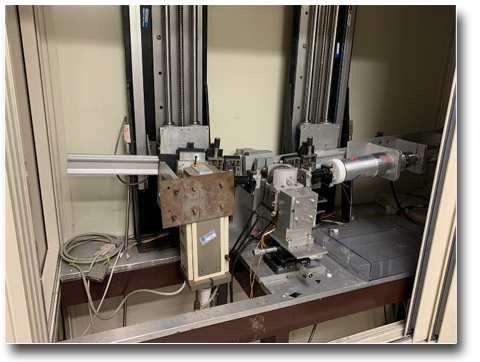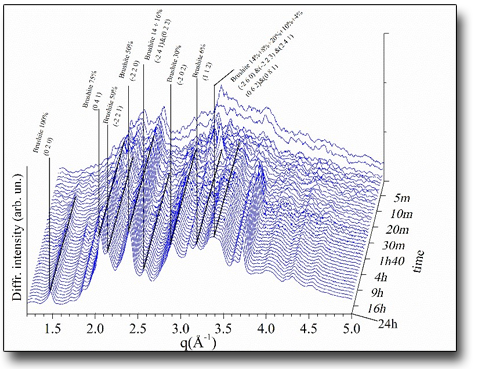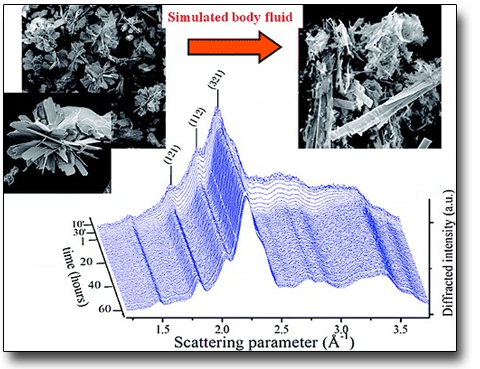
TECHNICAL SPECIFICATIONS
-
Tubo a raggi 0 – 100 keV W X-Ray Tube (not monochromatized)
-
0-50 kV Power Generator
-
Collimation slit with aperture size ranging from 5 µm to 10 mm
-
Ultrapure solid-state Ge photodiode detector (Ortek-Ametek)
-
Multichannel spectra analyzer (up to 2048 channels) (Ortek-Ametek) with energy resolution of about 1.5%
-
Lead ermined chassis
-
Automatized source and detector arms moved by two linear actuators driven by step motors, with minimum scattering angle increment of 0.004.
-
High temperature and ambient controlled cell
-
Rocking platform for anisotropically grown samples.
AVAILABLE TECHNIQUES
-
Ambient condition EDXRD measurement
-
High temperature, (fixed temperature, temperature ramp) EDXRD measurements
-
Gas-flux ambient measurement
SAMPLE
-
Sample lateral dimensions: 10 x 10 mm (ideal), 4 x 4 mm (minimal), 50 x 50 mm (maximal)
-
Sample thickness: ideally from 500 µm (thinner samples also feasible)
-
Bulk samples
-
Multilayered samples
-
Powder samples
-
Sample in the form of moldable paste
-
Deposited film samples
USE FOR
- Cements
- Thin films
- Coatings
- Biomedical samples
- Real time transformation in temperature
- Rocking measurements for samples grown with preferential orientation
Case Studies
Study of tricalcium phosphate cement supplemented with boron nitride nanotubes with enhanced biological properties
EDXRD patterns obtained during the hardening of the TCP cement containing 1 wt% BNNTs for a total duration of 24 h are presented in Figure on the left. Relevant changes in the EDXRD patterns were registered already within the first minutes of monitoring. However, a signal characteristic for poorly crystalline samples, along with some intense reflections coming from the TCP phase, characterize the patterns collected during the first 10 min. Afterwards, the TCP reflections disappear and a fast conversion into a new crystalline phase – brushite (DCPD)- is observed. This rapid conversion of TCP into the DCPD phase is indicated by the high intensity new born peaks.
See: Julietta V. Rau et al. /Mater. Sci. Eng. C, 2020, v. 114, p. 111044 DOI: 10.1016/j.msec.2020.111044


In situ time-resolved studies of octacalcium phosphate and dicalcium phosphate dihydrate in simulated body fluid
The present research was focused on the in vitro investigation of the biphasic octacalcium phosphate (OCP)−dicalcium phosphate dihydrate (DCPD) system transformations in simulated body fluid (SBF) for possible applications as bone substitute materials. The aim of this research is to outline the role of the additional component DCPD during transformation/crystallization processes. EDXRD technique was used for in situ monitoring of the processes taking place in the system in real time. Several OCP−DCPD combinations were investigated: (1) 100% OCP; (2) 70% OCP−30% DCPD; (3) 100% DCPD. The obtained experimental results allowed us to conclude that when only OCP is present in SBF, the formation of carbonated hydroxyapatite takes place, whereas for the OCP−DCPD (30%) system in SBF, less kinetically favorable hydroxyapatite is formed. The results obtained in this work provided some insights into the biomineralization mechanism.
See: Julietta V. Rau et al. Crystal Growth & Design ACS, 2010, vol. 10, pp. 3824-3834 DOI: 10.1021/cg100746a

 English (UK)
English (UK)  Italiano (Italia)
Italiano (Italia)